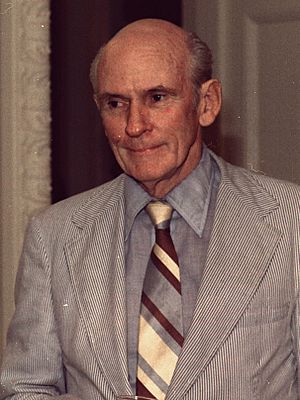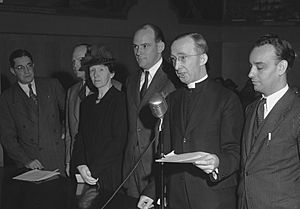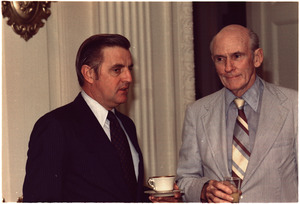Alan Cranston facts for kids
Quick facts for kids
Alan Cranston
|
|
|---|---|

Cranston in 1977
|
|
| Chair of the Senate Veterans Affairs Committee | |
| In office January 3, 1987 – January 3, 1993 |
|
| Preceded by | Frank Murkowski |
| Succeeded by | Jay Rockefeller |
| In office January 3, 1977 – January 3, 1981 |
|
| Preceded by | Vance Hartke |
| Succeeded by | Alan K. Simpson |
| Senate Majority Whip | |
| In office January 3, 1987 – January 3, 1991 |
|
| Leader | Robert Byrd George Mitchell |
| Preceded by | Alan K. Simpson |
| Succeeded by | Wendell Ford |
| In office January 3, 1977 – January 3, 1981 |
|
| Leader | Robert Byrd |
| Preceded by | Robert Byrd |
| Succeeded by | Ted Stevens |
| Senate Minority Whip | |
| In office January 3, 1981 – January 3, 1987 |
|
| Leader | Robert Byrd |
| Preceded by | Ted Stevens |
| Succeeded by | Alan K. Simpson |
| United States Senator from California |
|
| In office January 3, 1969 – January 3, 1993 |
|
| Preceded by | Thomas Kuchel |
| Succeeded by | Barbara Boxer |
| 25th Controller of California | |
| In office January 5, 1959 – January 2, 1967 |
|
| Governor | Pat Brown |
| Preceded by | Robert C. Kirkwood |
| Succeeded by | Houston I. Flournoy |
| Personal details | |
| Born |
Alan MacGregor Cranston
June 19, 1914 Palo Alto, California, U.S. |
| Died | December 31, 2000 (aged 86) Los Altos, California, U.S. |
| Political party | Democratic |
| Spouses |
Geneva McMath
(m. 1940; div. 1977)Norma Weintraub
(m. 1978; div. 1989) |
| Children | 2 |
| Education | Stanford University (BA) |
| Military service | |
| Branch/service | United States Army |
| Years of service | 1944–1945 |
| Battles/wars | World War II |
Alan MacGregor Cranston (June 19, 1914 – December 31, 2000) was an American politician and journalist. He served as a U.S. Senator for California from 1969 to 1993. He also led the World Federalist Association from 1949 to 1952.
Born in Palo Alto, California, Cranston became a journalist after college. He later served as the California State Controller. In 1968, he was elected to the Senate. He was the Senate Democratic Whip from 1977 to 1991. In 1984, Cranston ran for president. He wanted to stop the spread of nuclear weapons during the Cold War. He left the race after the first few primary elections.
In 1991, a Senate committee looked into his actions. He then decided not to run for another term. After leaving the Senate, he worked to get rid of nuclear weapons worldwide. He led the Global Security Institute.
Contents
Alan Cranston's Early Life and Education
Alan Cranston was born in Palo Alto, California. His parents were Carol and William MacGregor Cranston. He went to Pomona College for a year. He also studied in Mexico for a summer. In 1936, he graduated from Stanford University. He earned a degree in English.
Alan Cranston's Career Before Politics

Before World War II, Cranston worked as a reporter. He wrote for the International News Service. He once published a different translation of Adolf Hitler's book, Mein Kampf. The original English version left out some of Hitler's harsh ideas. Cranston's version showed the true content. This helped many people understand the danger Hitler posed.
In 1944, Cranston joined the United States Army. He worked as an editor for Army Talk magazine. He also wrote a book called The Killing of the Peace. This book was about why the U.S. did not join the League of Nations after World War I. He left the army in 1945 as a sergeant.
Cranston believed in a world government. He became president of the World Federalist Association in 1948. He worked to get the U.S. to join a world government. He also strongly opposed nuclear weapons. In 1952, he helped start the California Democratic Council. This group helped coordinate Democratic activities in California.
Alan Cranston's Public Service
Serving as California State Controller
Cranston was a member of the Democratic Party. He was elected California State Controller in 1958. He was reelected in 1962. He lost his reelection bid in 1966.
Serving as a U.S. Senator
In 1968, Cranston was elected to the United States Senate. He served four terms as a senator. He won against Max Rafferty.
During his first months in the Senate, Cranston worked on important issues. He tried to stop the closing of Job Corps Centers. These centers helped young people get job training. He also spoke out against the military draft.
In 1973, Cranston suggested reducing U.S. forces overseas. He supported Gerald Ford for vice president. Cranston said he talked to many people in California. They mostly agreed with his support for Ford.
In 1974, Cranston won reelection. He beat H.L. Richardson. Cranston received about 60% of the votes.
In 1980, Cranston won reelection again. He defeated Paul Gann. His campaign had a special event. The band The Eagles played their last concert together for 14 years at a benefit for Cranston.
Cranston also spoke about nuclear weapons. In 1981, he warned that India and Pakistan might test nuclear devices. He said this information came from reliable sources.
Cranston was reelected in 1986. He won against Ed Zschau.
Running for President

Cranston was the Democratic Whip in the Senate. He held this role from 1977 to 1991.
He ran for president in the 1984 election. He was the first person to announce his candidacy in February 1983. Cranston was 69 years old. He strongly supported a nuclear freeze. This idea meant stopping the production of more nuclear weapons. Many anti-nuclear activists supported him. He won some early straw polls. However, he dropped out of the race after poor results in Iowa and New Hampshire.
After his presidential campaign, Cranston faced debt. He then had a tough reelection fight in 1986. He narrowly won against Ed Zschau.
Senate Committee Review
In 1991, a Senate committee looked into Cranston's actions. This was related to contributions from a businessman named Charles Keating. The committee found that Cranston had acted improperly. They said he did not agree to help Keating for money. But his conduct was still seen as wrong. Cranston was diagnosed with prostate cancer. He decided not to run for a fifth term. Barbara Boxer took his place as California's senior senator.
Track and Field Involvement
Throughout his life, Cranston loved track and field. He was a sprinter in special races for older athletes. These races later became known as masters athletics. He would even sprint in hotel hallways to stay fit while traveling.
Alan Cranston's Personal Life
Alan Cranston came from a wealthy family. They had investments in real estate. He was married twice. He had two sons with his first wife, Geneva McMath. His son Robin died young in a car accident. His son Kim survived him. Cranston later married Norma Weintraub.
Retirement and Death
After retiring from the Senate, Cranston focused on a big goal. He wanted to get rid of nuclear weapons around the world. He worked with the State of the World Forum. In 1999, he founded the Global Security Institute. He served as its president.
He lived in Los Altos, California, until he passed away on December 31, 2000.
See Also
- Global Security Institute

